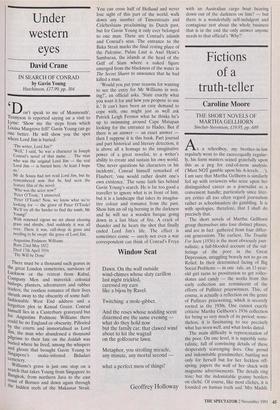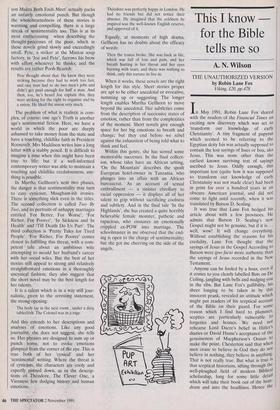Fictions of a truth-teller
Caroline Moore
THE SHORT NOVELS OF MARTHA GELLHORN Sinclair-Stevenson, £19.95, pp. 689
As a schoolboy, my brother-in-law regularly went to the races;equally regular- ly, his form masters seized gratefully upon this as a peg for end-of-term analysis. (`Must NOT gamble upon his A-levels.. .'). I am sure that Martha Gellhorn is similarly fed up with reviewers who seize upon her distinguished career as a journalist as a convenient handle; particularly since liter- ary critics all too often regard journalism rather as schoolmasters do gambling. It is with apologies, therefore, that I shall do precisely that.
The short novels of Martha Gellhorn group themselves into four distinct phases, and are in fact gathered from four differ- ent generations. The earliest, The Trouble I've Seen (1936) is the most obviously jour- nalistic; a full-blooded account of the suf- ferings of the poor in the Great Depression, struggling bravely not to go on Relief. In their determined facing of Big Social Problems — in one tale, an 11-year- old girl turns to prostitution to get roller- skates and candy — the works from this early collection are reminiscent of the efforts of Pullitzer prizewinners. This, of course, is actually a reflection on the genre of Pullitzer prizewriting, which is securely rooted in the 1930s. One cannot, exactly criticise Martha Gellhorn's 1936 collection for being so very much of its period; none- theless, it is fascinating to see precisely what has worn well, and what looks dated.
The main difficulty is representation of the poor. On one level, it is superbly natu- ralistic, full of convincing details of these desperately scavenging lives. One proud and indomitable grandmother, battling not only for herself but for her feckless off- spring, papers the wall of her shack with magazine advertisements. The details ring true; but the indomitable granny borders on cliche. Of course, like most clichés, it is founded on human truth and 'Mrs Maddi- son Makes Both Ends Meet' actually packs an unfairly emotional punch. But though the wholeheartedness of these stories is warming and compelling, there is a large streak of sentimentality too. This is at its most embarrassing when describing the thought-processes of the poor, which in these novels grind slowly and exceedingly small. Pete, a striker at the Minton soup factory, in `Joe and Pete', furrows his brow with effort whenever he thinks; and the results are rather Pooh-Bearish:
Pete thought about that. He knew they were striking because they had to work too fast, and one man had to do two men's jobs and didn't get paid enough for half a man. And then, too, he's heard Joe explain this, they were striking for the right to organise and be a union. He liked the union very much.
The problem of what is realistic is com- plex, of course: one age's Truth is another age's sentimental fiction. Here, we have a world in which the poor are deeply ashamed to take money from the state and have a touching, childlike faith in President Roosevelt. Mrs Maddison writes him a long letter with a stubby pencil. It is difficult to imagine a time when this might have been true to life; but if a well-informed contemporary writer was able to maintain a touching and childlike credulousness, any- thing is possible.
In Martha Gellhorn's next two phases, the danger is that sentimentality may turn to easy cynicism, Maugham-ish ironies. There is something slick even in the titles. The second collection is called Two By Two, and its portraits of unhappy marriages entitled 'For Better, For Worse', 'For Richer, For Poorer', 'In Sickness and In Health' and 'Till Death Do Us Part'. The third collection is 'Pretty Tales for Tired People'. 'For Richer, For Poorer' comes closest to fulfilling this threat, with a com- petent tale about an ambitious wife attempting to mould her husband's career with her social wiles. But the best of her stories still appeal to strong and relatively straightforward emotions in a thoroughly uncynical fashion; they also suggest that the short novel may be the best length for her talents.
It is a -talent which is in a way still jour- nalistic, given to the arresting statement, the strong opening:
The body lay in the next room , under a dirty tablecloth. The Colonel was in a rage.
And this extends to her descriptions and analyses of emotions. Like any good journalist, she does not suggest, she tells us. Her phrases are designed to sum up or punch home, not to evoke emotions glimpsed from the corner of the eye. This is true both of her 'cynical' and her 'sentimental' writing. Where the threat is of cynicism, the characters are cooly and expertly pinned down, as in the descrip- tions of Theodore, The Clever One, a Viennese Jew dodging history and human emotions.
Theodore was perfectly happy in London. He had no friends but did not notice their absence. He imagined that the coldness he inspired was the well-known English reserve, and approved of it.
Equally, at moments of high drama, Gellhorn has no doubts about the efficacy of words:
Then the trance broke. She was back in life, which was full of loss and pain, and her breath hurting in her throat and her eyes burning with tears, and there was nothing to think, only this torture Co live in.
When it works, these novels are the right length for this style. Short stories proper are apt to be either anecdotal or evocative, summing up or suggesting. The longer length enables Martha Gellhorn to move beyond the anecdotal. Her subtleties come from the description of successive states of emotion, rather than from the complexities of the moment. Short novels give enough space for her big emotions to breath and change; but they end before we rebel against the exhaustion of being told what to think and feel.
Within this genre, she has scored some memorable successes. In the final collect- ion, whose tales have an African setting, 'On the Mountain' describes the spoilt European hotel-owner in Tanzania, who plunges into an affair with an African bureaucrat. As an account of sexual enthrallment — a sinister corollary to racial oppression — it displays all of her talent to grip without sacrificing coolness and subtlety. And in the final tale 'In the Highlands', she has created a quite horribly believable female monster, pathetic and rapacious, who ensnares an emotionally crippled ex-POW into marriage. The schoolmaster in me observed that the end- ing is open to the charge of sentimentality; but she got me cheering on the side of the angels.



































































 Previous page
Previous page